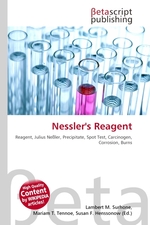Nesslers Reagent
Lambert M. Surhone, Miriam T. Timpledon, Susan F. Marseken
бумажная книга
High Quality Content by WIKIPEDIA articles! Nessler's reagent is a reagent named after Julius Nessler and is used to detect small amounts of ammonium ions.. It is a 0.09 mol/L solution of potassium tetraiodomercurate(II) (K2[HgI4]) in 2.5 mol/L potassium hydroxide. A yellow coloration indicates the presence of ammonia: at higher concentrations, a brown precipitate may form. The sensitivity as a spot test is about 0.3 ?g NH3 in 2 ?L. It is toxic if swallowed, inhaled or absorbed through the skin. It presents a neurological hazard and may act as a carcinogen and be a reproductive hazard. It is corrosive and causes burns. Nessler's reagent is generally prepared from potassium iodide and mercury(II) iodide. A hot concentrated solution of mercury(II) chloride is added to concentrated solution of potassium iodide, until the precipitate of mercury(II) iodide stops dissolving. The liquid is filtered, and potassium hydroxide and a further bit of mercury(II) chloride solution are added. The resulting solution is then cooled and diluted to required concentration. Nessler's reagent may be used with Nessler tubes.
Данное издание не является оригинальным. Книга печатается по технологии принт-он-деманд после получения заказа.


